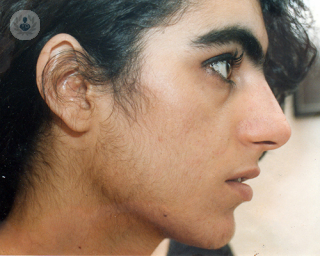Hirsutism
Professor Gordana Prelevic - Endocrinology, diabetes & metabolism
Created on: 11-05-2015
Updated on: 04-25-2023
Edited by: Carlota Pano
What is hirsutism?
Hirsutism is the excessive hair growth in women, which develops in areas where men often have hair, such as the face (upper lip, chin, sideburns), neck, chest, tummy, lower back, buttocks and thighs. Some women find the situation distressing and embarrassing to live with.
Hyperandrogenism is the result of hyperandrogenaemia, which is the excessive amount of male hormones (androgens) in a woman's body. Testosterone, the main androgen hormone responsible for the development of secondary sexual characteristics in men, could also be produced in a female body but in significantly lesser amounts. Other androgen hormones are androstenedione and DHEA-S - both are produced in very small amounts in the ovaries and the adrenal glands.
Hirsutism is one of the main clinical signs of hyperandrogenism, which may also include oily skin, acne, deepening of the voice, and irregular or absent periods.

What are the causes of hirsutism?
Hirsutism is caused by an excess of male hormones (testosterone, androstenedione and DHEA-S) in a woman's body. It may be accompanied by other signs of hyperandrogenism, such as acne, deep voice, scalp hair loss and enlargement of clitoris.
The commonest cause of hirsutism is polycystic ovary syndrome (PCOS), which often causes irregular and/or absent periods. Hirsutism may also be genetic and run in families, so called idiopathic hirsutism. It is more common in women from the Middle East, South Asia and the Mediterranean.
Other causes may include:
- Cushing’s syndrome - excessive production of androgen hormones by adrenal gland tumour or hyperplasia
- Congenital adrenal hyperplasia - an inherited condition, which affects the adrenal glands
- Medications - anabolic steroids, glucocorticoids, testosterone, DHEA, danazol, cyclosporine, minoxidil, phenytoin, etc.
What is the treatment for hirsutism?
The main treatments include:
- Medications - oral contraceptive pills suppress the production of androgen hormones in the ovaries, and anti-androgens block the effect of excessive androgen at the hair follicle in the skin
- Eflornithine cream - a non-hormonal prescription cream to slow down the growth of facial hair
- Specialist hair removal – electrolysis, where electricity is used to destroy the hair follicles, and laser hair removal, where beams of light are used to destroy hair
- Home hair removal methods - (read more below)
The best results in the control of hirsutism are achieved with the combination of medical treatment and concurrent mechanical removal of unwanted hairs. The process of achieving reasonable good control is very slow and takes years.
What are the home hair removal techniques?
As home hair removal techniques are inexpensive, they will need to be carried out on a regular basis. The main ones are:
- Shaving
- Bleaching
- Waxing, plucking or threading
- Use of Epilators




